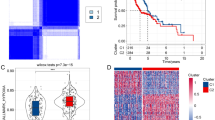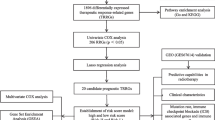Abstract
Objective
Head and neck squamous cell carcinoma (HNSCC) are a highly aggressive tumor with an extremely poor prognosis. Thus, we aimed to develop and validate a robust prognostic signature that can estimate the prognosis for HNSCC.
Methods
Data on gene expressions and clinical were downloaded from TCGA and GEO database. To develop the best prognosis signature, a LASSO Cox Regression model was employed. Time-dependent receiver-operating characteristic (ROC) was used to determine the best cut-off value. Patients were divided into high-risk and low-risk hypoxia groups according to cut-off value. Survival differences were evaluated by log-rank test, while multivariate analysis was performed by a Cox proportional hazards model.
Results
A 17-HRGPs composed of 24 unique genes was constructed, which was significantly related to OS. In the TCGA and GEO datasets, patients in the high hypoxia risk group have a poor prognosis (TCGA: P < 0.001, GEO: P < 0.05). After adjusting for other clinicopathological parameters, the 17-HRGP signature was independent prognostic factors in patients with HNSCC (P < 0.05). Functional analysis revealed that mRNA binding, gene silencing by RNA, RNA binding involved in posttranscriptional gene silencing signaling pathway were enriched in the low-risk groups. For this model, C-index was 0.684, which was higher than that of many established risk models. Macrophages M0, Mast cells activated, NK cells resting, T cells CD4 memory resting, etc. were significantly higher in the high-risk group, and B cells memory, Plasma cells, T cells follicular helper, T cells gamma delta, T cells CD8, etc. were significantly higher in the low-risk group.
Conclusion
In summary, our study constructed a robust HRGPs signature as molecular markers for predicting the outcome of HNSCC patients.









Similar content being viewed by others
Availability of data and materials
The raw data of this study are derived from the TCGA database (https://portal.gdc.cancer.gov/) and GEO data portal (https://www.ncbi.nlm.nih.gov/geo/), which are publicly available databases.
Abbreviations
- HNSCC:
-
Head and neck squamous cell carcinoma
- HRGPs:
-
Hypoxia-related gene pairs
- OS:
-
Overall survival
- TCGA:
-
The Cancer Genome Atlas
- GEO:
-
Gene Expression Omnibus
- LASSO:
-
Least absolute shrinkage and selection operator
- GO:
-
Gene Ontology
- ROC:
-
Receiver Operating Characteristic
- AUC:
-
Area Under the ROC Curve
- GSEA:
-
Gene Set Enrichment Analysis
References
Siegel RL, Miller KD, Jemal A (2018) Cancer statistics. CA Cancer J Clin 68(1):7–30. https://doi.org/10.3322/caac.21442
Kobayashi K, Hisamatsu K, Suzui N, Hara A, Tomita H, Miyazaki T (2018) A review of HPV-related head and neck cancer. J Clin Med. https://doi.org/10.3390/jcm7090241
Lydiatt WM, Patel SG, Sullivan B, Brandwein MS, Ridge JA, Migliacci JC, Loomis AM, Shah JP (2017) Head and Neck cancers-major changes in the American Joint Committee on cancer eighth edition cancer staging manual. CA Cancer J Clin 67(2):122–137. DOI: https://doi.org/10.3322/caac.21389
Hatcher JL, Sterba KR, Tooze JA, Day TA, Carpenter MJ, Alberg AJ, Sullivan CA, Fitzgerald NC, Weaver KE (2016) Tobacco use and surgical outcomes in patients with head and neck cancer. Head Neck 38(5):700–706. https://doi.org/10.1002/hed.23944
Schmidt H, Kulasinghe A, Perry C, Nelson C, Punyadeera C (2016) A liquid biopsy for head and neck cancers. Expert Rev Mol Diagn 16(2):165–172. https://doi.org/10.1586/14737159.2016.1127758
Zhao X, Cui L (2020) A robust six-miRNA prognostic signature for head and neck squamous cell carcinoma. J Cell Physiol. https://doi.org/10.1002/jcp.29723
Zhao X, Si S, Li X, Sun W, Cui L (2020) Identification and validation of an alternative splicing-based prognostic signature for head and neck squamous cell carcinoma. J Cancer 11(15):4571–4580. https://doi.org/10.7150/jca.44746
She Y, Kong X, Ge Y, Yin P, Liu Z, Chen J, Gao F, Fang S (2020) Immune-related gene signature for predicting the prognosis of head and neck squamous cell carcinoma. Cancer Cell Int 20:22. https://doi.org/10.1186/s12935-020-1104-7
Subramanian J, Simon R (2010) Gene expression-based prognostic signatures in lung cancer: ready for clinical use? J Natl Cancer Inst 102(7):464–474. https://doi.org/10.1093/jnci/djq025
Leek JT, Scharpf RB, Bravo HC, Simcha D, Langmead B, Johnson WE, Geman D, Baggerly K, Irizarry RA (2010) Tackling the widespread and critical impact of batch effects in high-throughput data. Nat Rev Genet 11(10):733–739. https://doi.org/10.1038/nrg2825
Zhao E, Zhou C, Chen S (2020) A signature of 14 immune-related gene pairs predicts overall survival in gastric cancer. Clin Transl Oncol. https://doi.org/10.1007/s12094-020-02414-7
Zhang L, Zhu P, Tong Y, Wang Y, Ma H, Xia X, Zhou Y, Zhang X, Gao F, Shu P (2019) An immune-related gene pairs signature predicts overall survival in serous ovarian carcinoma. OncoTargets and therapy 12:7005–7014. https://doi.org/10.2147/ott.S200191
Li B, Cui Y, Diehn M, Li R (2017) Development and validation of an individualized immune prognostic signature in early-stage nonsquamous non-small cell lung cancer. JAMA oncology 3(11):1529–1537. https://doi.org/10.1001/jamaoncol.2017.1609
Heinäniemi M, Nykter M, Kramer R, Wienecke-Baldacchino A, Sinkkonen L, Zhou JX, Kreisberg R, Kauffman SA, Huang S, Shmulevich I (2013) Gene-pair expression signatures reveal lineage control. Nat Methods 10(6):577–583. https://doi.org/10.1038/nmeth.2445
Ruan K, Song G, Ouyang G (2009) Role of hypoxia in the hallmarks of human cancer. J Cell Biochem 107(6):1053–1062. https://doi.org/10.1002/jcb.22214
Walsh JC, Lebedev A, Aten E, Madsen K, Marciano L, Kolb HC (2014) The clinical importance of assessing tumor hypoxia: relationship of tumor hypoxia to prognosis and therapeutic opportunities. Antioxid Redox Signal 21(10):1516–1554. https://doi.org/10.1089/ars.2013.5378
Muz B, de la Puente P, Azab F, Azab AK (2015) The role of hypoxia in cancer progression, angiogenesis, metastasis, and resistance to therapy. Hypoxia (Auckland, NZ) 3:83–92. https://doi.org/10.2147/hp.S93413
Vaupel P (2008) Hypoxia and aggressive tumor phenotype: implications for therapy and prognosis. Oncologist 13(Suppl 3):21–26. https://doi.org/10.1634/theoncologist.13-S3-21
Feng H, Zhong L, Yang X, Wan Q, Pei X, Wang J (2020) Development and validation of prognostic index based on autophagy-related genes in patient with head and neck squamous cell carcinoma. Cell Death Discov 6:59. https://doi.org/10.1038/s41420-020-00294-y
Yang J, Xie K, Li C (2020) Immune-related genes have prognostic significance in head and neck squamous cell carcinoma. Life Sci 256:117906. https://doi.org/10.1016/j.lfs.2020.117906
Jin Y, Qin X (2020) Comprehensive analysis of the roles and prognostic value of RNA-binding proteins in head and neck squamous cell carcinoma. DNA Cell Biol. https://doi.org/10.1089/dna.2020.5641
Seiwert TY, Cohen EE (2005) State-of-the-art management of locally advanced head and neck cancer. Br J Cancer 92(8):1341–1348. https://doi.org/10.1038/sj.bjc.6602510
Brown JM, Wilson WR (2004) Exploiting tumour hypoxia in cancer treatment. Nat Rev Cancer 4(6):437–447. https://doi.org/10.1038/nrc1367
Lunt SJ, Chaudary N, Hill RP (2009) The tumor microenvironment and metastatic disease. Clin Exp Metas 26(1):19–34. https://doi.org/10.1007/s10585-008-9182-2
Hill RP, Bristow RG, Fyles A, Koritzinsky M, Milosevic M, Wouters BG (2015) Hypoxia and predicting radiation response. Semin Radiat Oncol 25(4):260–272. https://doi.org/10.1016/j.semradonc.2015.05.004
Salem A, Asselin MC, Reymen B, Jackson A, Lambin P, West CML, O’Connor JPB, Faivre-Finn C (2018) Targeting hypoxia to improve non-small cell lung cancer outcome. J Natl Cancer Inst. https://doi.org/10.1093/jnci/djx160
Rey S, Schito L, Wouters BG, Eliasof S, Kerbel RS (2017) Targeting hypoxia-inducible factors for antiangiogenic cancer therapy. Trends Cancer 3(7):529–541. https://doi.org/10.1016/j.trecan.2017.05.002
Zou YF, Rong YM, Tan YX, Xiao J, Yu ZL, Chen YF, Ke J, Li CH, Chen X, Wu XJ, Lan P, Lin XT, Gao F (2019) A signature of hypoxia-related factors reveals functional dysregulation and robustly predicts clinical outcomes in stage I/II colorectal cancer patients. Cancer Cell Int 19:243. https://doi.org/10.1186/s12935-019-0964-1
Yang L, Taylor J, Eustace A, Irlam JJ, Denley H, Hoskin PJ, Alsner J, Buffa FM, Harris AL, Choudhury A, West CML (2017) A gene signature for selecting benefit from hypoxia modification of radiotherapy for high-risk bladder cancer patients. Clin Cancer Res 23(16):4761–4768. https://doi.org/10.1158/1078-0432.Ccr-17-0038
Yang L, Roberts D, Takhar M, Erho N, Bibby BAS, Thiruthaneeswaran N, Bhandari V, Cheng WC, Haider S, McCorry AMB, McArt D, Jain S, Alshalalfa M, Ross A, Schaffer E, Den RB, Jeffrey Karnes R, Klein E, Hoskin PJ, Freedland SJ, Lamb AD, Neal DE, Buffa FM, Bristow RG, Boutros PC, Davicioni E, Choudhury A, West CML (2018) Development and validation of a 28-gene hypoxia-related prognostic signature for localized prostate cancer. EBioMedicine 31:182–189. https://doi.org/10.1016/j.ebiom.2018.04.019
Ye IC, Fertig EJ, DiGiacomo JW, Considine M, Godet I, Gilkes DM (2018) Molecular portrait of hypoxia in breast cancer: a prognostic signature and novel HIF-regulated genes. Mol Cancer Res MCR 16(12):1889–1901. https://doi.org/10.1158/1541-7786.Mcr-18-0345
Eddy JA, Sung J, Geman D, Price ND (2010) Relative expression analysis for molecular cancer diagnosis and prognosis. Technol Cancer Res Treat 9(2):149–159. https://doi.org/10.1177/153303461000900204
Popovici V, Budinska E, Tejpar S, Weinrich S, Estrella H, Hodgson G, Van Cutsem E, Xie T, Bosman FT, Roth AD, Delorenzi M (2012) Identification of a poor-prognosis BRAF-mutant-like population of patients with colon cancer. J Clin Oncol 30(12):1288–1295. https://doi.org/10.1200/jco.2011.39.5814
Sethuraman A, Brown M, Krutilina R, Wu ZH, Seagroves TN, Pfeffer LM, Fan M (2018) BHLHE40 confers a pro-survival and pro-metastatic phenotype to breast cancer cells by modulating HBEGF secretion. Breast Cancer Res BCR 20(1):117. https://doi.org/10.1186/s13058-018-1046-3
Yang JD, Ma L, Zhu Z (2019) SERPINE1 as a cancer-promoting gene in gastric adenocarcinoma: facilitates tumour cell proliferation, migration, and invasion by regulating EMT. J Chemother (Florence, Italy) 31(7–8):408–418. https://doi.org/10.1080/1120009x.2019.1687996
Xu J, Zhu X, Li Q, Chen C, Guo Z, Tan Z, Zheng C, Ge M (2018) Loss of PIM1 correlates with progression and prognosis of salivary adenoid cystic carcinoma (SACC). Cancer Cell Int 18:22. https://doi.org/10.1186/s12935-018-0518-y
Cheng Z, Dai Y, Pang Y, Jiao Y, Liu Y, Cui L, Quan L, Qian T, Zeng T, Si C, Huang W, Chen J, Pang Y, Ye X, Shi J, Fu L (2020) Up-regulation of DDIT4 predicts poor prognosis in acute myeloid leukaemia. J Cell Mol Med 24(1):1067–1075. https://doi.org/10.1111/jcmm.14831
Destek S, Gul VO (2018) S100A4 may be a good prognostic marker and a therapeutic target for colon cancer. J Oncol 2018:1828791. https://doi.org/10.1155/2018/1828791
Hoffmann C, Mao X, Brown-Clay J, Moreau F, Al Absi A, Wurzer H, Sousa B, Schmitt F, Berchem G, Janji B, Thomas C (2018) Hypoxia promotes breast cancer cell invasion through HIF-1α-mediated up-regulation of the invadopodial actin bundling protein CSRP2. Sci Rep 8(1):10191. https://doi.org/10.1038/s41598-018-28637-x
Bao Y, Wang Z, Liu B, Lu X, Xiong Y, Shi J, Li P, Chen J, Zhang Z, Chen M, Wang L, Wu Z (2019) A feed-forward loop between nuclear translocation of CXCR4 and HIF-1α promotes renal cell carcinoma metastasis. Oncogene 38(6):881–895. https://doi.org/10.1038/s41388-018-0452-4
Liotta LA, Kohn EC (2001) The microenvironment of the tumour-host interface. Nature 411(6835):375–379. https://doi.org/10.1038/35077241
Yang S, Wu Y, Deng Y, Zhou L, Yang P, Zheng Y, Zhang D, Zhai Z, Li N, Hao Q, Song D, Kang H, Dai Z (2019) Identification of a prognostic immune signature for cervical cancer to predict survival and response to immune checkpoint inhibitors. Oncoimmunology 8(12):e1659094. https://doi.org/10.1080/2162402x.2019.1659094
Ali HR, Chlon L, Pharoah PD, Markowetz F, Caldas C (2016) Patterns of immune infiltration in breast cancer and their clinical implications: a gene-expression-based retrospective study. PLoS Med 13(12):e1002194. https://doi.org/10.1371/journal.pmed.1002194
Zhang Z, Ma L, Goswami S, Ma J, Zheng B, Duan M, Liu L, Zhang L, Shi J, Dong L, Sun Y, Tian L, Gao Q, Zhang X (2019) Landscape of infiltrating B cells and their clinical significance in human hepatocellular carcinoma. Oncoimmunology 8(4):e1571388. https://doi.org/10.1080/2162402x.2019.1571388
Chang CH, Qiu J, O’Sullivan D, Buck MD, Noguchi T, Curtis JD, Chen Q, Gindin M, Gubin MM, van der Windt GJ, Tonc E, Schreiber RD, Pearce EJ, Pearce EL (2015) Metabolic competition in the tumor microenvironment is a driver of cancer progression. Cell 162(6):1229–1241. https://doi.org/10.1016/j.cell.2015.08.016
Funding
None.
Author information
Authors and Affiliations
Contributions
This research was conducted in collaboration with all authors. DZ and LHF performed the data curation and analysis. D.Z. analyzed and interpreted the results. DZ and YDS drafted and reviewed the manuscript. All authors read and approved the final manuscript.
Corresponding author
Ethics declarations
Conflict of interest
The authors declare that they have no competing interests.
Ethics approval and consent to participate
No permissions were required to use the repository data.
Additional information
Publisher's Note
Springer Nature remains neutral with regard to jurisdictional claims in published maps and institutional affiliations.
Rights and permissions
About this article
Cite this article
Ding, Z., Li, H. & Yu, D. Development and validation of a hypoxia-related gene pair signature to predict overall survival in head and neck squamous cell carcinoma. Eur Arch Otorhinolaryngol 278, 3973–3983 (2021). https://doi.org/10.1007/s00405-020-06580-w
Received:
Accepted:
Published:
Issue Date:
DOI: https://doi.org/10.1007/s00405-020-06580-w




